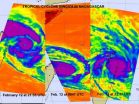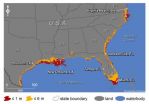(Press-News.org) Tropical Cyclone Bingiza has made landfall in northeastern Madagascar, and NASA's Aqua and Terra satellites captured visible infrared satellite data of the storm's progression over the weekend, revealing the power behind the storm.
The movement and landfall of Tropical Cyclone Bingiza was captured over the weekend of Feb. 12-13 in a series of infrared satellite imagery from the Atmospheric Infrared Sounder (AIRS) instrument that flies aboard NASA's Aqua satellite. Aqua and Terra provided companion visible images to the infrared images of Bingiza's track across northern Madagascar.
On February 12 at 21:35 UTC (4:35 p.m. EST or 12:35 a.m. on Feb. 13 Madagascar local time) Cyclone Bingiza's center was still at sea, and an eye was visible indicating that the cyclone had strengthened. Madagascar time is GMT time plus three hours. On Feb. 13 at 0947 UTC (4:47 EST) AIRS noticed the western edge of Bingiza was already bringing rainfall and gusty winds over northeastern Madagascar and the storm appeared to be expanding. A large band of thunderstorms had developed and were wrapped around the outer eastern edge of the cyclone at that time. On Feb. 13 at 22:17 UTC (5:17 p.m. EST), Bingiza's center was on the northeastern coastline and it was making landfall. The center of Cyclone Bingiza made landfall today, Feb. 14 at 0600 UTC (1 a.m. EST) after moving across the Masoala Peninsula and skirting Antongil Bay.
In all of these data, there were large areas of very cold cloud tops, as cold as or colder than -63 Fahrenheit (-52 Celsius). Those areas indicated strong thunderstorms, strong convection (rapidly rising air that forms those thunderstorms) and heavy rainfall.
Today, Feb. 14 at 0900 UTC (4 a.m. EST), Cyclone Bingiza had maximum sustained winds of 85 knots (98 mph / 157 kmh) over land. It was located about 250 nautical miles (287 miles/463 km) northeast of Antananarivo, Madagascar, near 16.0 South and 49.3 East. It was moving westward near 8 knots (9 mph/15 kmh).
Currently there are warnings posted for Malagasy. Heavy rainfall is expected to be the main hazard for northern Madagascar.
This morning's (Feb. 14) infrared AIRS satellite image from 10:23 UTC (5:23 a.m. EST) shows northern Madagascar covered by the storm. It also showed that Bingiza remained well-organized with tightly-curved convective thunderstorm banding wrapping into a well-defined low-level circulation center. It continues to draw energy from the warm waters of the Southern Indian Ocean.
Although the storm was still at hurricane strength at that time, no eye was visible in the infrared image. The strongest thunderstorms and coldest (-63F/-52C), highest cloud tops were over north central Madagascar and over the Mozambique Channel. The imagery also showed that the western edge of Bingiza was already over the Mozambique Channel. AIRS images are created at NASA's Jet Propulsion Laboratory, in Pasadena, Calif.
At NASA's Goddard Space Flight Center in Greenbelt, Md. the MODIS Rapid Response Team created visible images of Bingiza on Feb. 13 and 14. The Moderate Resolution Imaging Spectroradiometer (MODIS) instrument that flies aboard NASA's Terra and Aqua satellites captured two images of Cyclone Bingiza before and after it crossed northern Madagascar on Feb. 13 and 14 respectively. The image on Feb. 13 showed an eye in the storm's center which disappeared after Bingiza made landfall.
The forecasters at the Joint Typhoon Warning Center expect Bingiza to continue tracking west-southwestward over land over the next 36 hours while rapidly weakening. The storm is expected to track over northern Madagascar and by Feb. 16 it will move into the Mozambique Channel where it is expected to regenerate in the warm waters (30 degrees Celsius) and low wind shear. Once in the Channel, forecasters expect that it will be steered southwestward to southward.
Forecasts currently differ on the end Bingiza's life. Some models predict a second landfall in southern Madagascar right now, while others keep the storm at sea.
INFORMATION:
NASA satellites see Cyclone Bingiza move across northern Madagascar
2011-02-15
ELSE PRESS RELEASES FROM THIS DATE:
Heart patients should be referred to Cardiac Rehabilitation before leaving hospital
2011-02-15
Healthcare practitioners can increase the number of patients with heart disease referred to a cardiac rehabilitation program by 40 per cent, helping them to reduce their risk of dying and improve their quality of life, say researchers at the Peter Munk Cardiac Centre.
Previous studies, including one by Taylor in 2004, indicate that participating in cardiac rehab after a cardiac illness, such as a heart attack, can reduce the risk of death by approximately 25 per cent, a reduction similar to that of other standard therapies such as cholesterol-lowering medications (statins) ...
Earliest humans not so different from us, research suggests
2011-02-15
That human evolution follows a progressive trajectory is one of the most deeply-entrenched assumptions about our species. This assumption is often expressed in popular media by showing cavemen speaking in grunts and monosyllables (the GEICO Cavemen being a notable exception). But is this assumption correct? Were the earliest humans significantly different from us?
In a paper published in the latest issue of Current Anthropology, archaeologist John Shea (Stony Brook University) shows they were not.
The problem, Shea argues, is that archaeologists have been focusing ...
Rising seas will affect major US coastal cities by 2100
2011-02-15
Rising sea levels could threaten an average of 9 percent of the land within 180 U.S. coastal cities by 2100, according to new research led by University of Arizona scientists.
The Gulf and southern Atlantic coasts will be particularly hard hit. Miami, New Orleans, Tampa, Fla., and Virginia Beach, Va. could lose more than 10 percent of their land area by 2100.
The research is the first analysis of vulnerability to sea-level rise that includes every U.S. coastal city in the lower 48 with a population of 50,000 or more.
The latest scientific projections indicate that ...
Monitoring killer mice from space
2011-02-15
SALT LAKE CITY, Feb. 15, 2011 – The risk of deadly hantavirus outbreaks in people can be predicted months ahead of time by using satellite images to monitor surges in vegetation that boost mouse populations, a University of Utah study says. The method also might forecast outbreaks of other rodent-borne illnesses worldwide.
"It's a way to remotely track a disease without having to go out and trap animals all the time," says Denise Dearing, professor of biology at the University of Utah and co-author of the study published online Wednesday, Feb. 16, in the journal Global ...
Breast cancer screening with MRI benefits women with radiation therapy history
2011-02-15
OAK BROOK, Ill. – Breast cancer screening with MRI can detect invasive cancers missed on mammography in women who've undergone chest irradiation for other diseases, according to a new study published online and in the April print edition of Radiology.
Women who receive radiation therapy as children and young adults for diseases like Hodgkin's lymphoma face a significantly greater risk of breast cancer later in life. The incidence of breast cancer increases approximately eight years after chest irradiation, and 13 percent to 20 percent of women treated with moderate- to ...
Updated heart disease prevention guidelines for women focus more on 'real-world' recommendations
2011-02-15
Practical medical advice that works in the "real world" may more effectively prevent cardiovascular disease in women than recommendations based only on findings in clinical research settings, according to the 2011 update to the American Heart Association's cardiovascular disease prevention guidelines for women.
First published in 1999, the guidelines until now have been primarily based on findings observed in clinical research. That alone often doesn't consider the personal and socioeconomic factors that can keep women from following medical advice and treatment.
"These ...
New study finds no cognitive impairment among ecstasy users
2011-02-15
The drug known as ecstasy has been used by 12 million people in the United States alone and millions more worldwide. Past research has suggested that ecstasy users perform worse than nonusers on some tests of mental ability.
But there are concerns that the methods used to conduct that research were flawed, and the experiments overstated the cognitive differences between ecstasy users and nonusers.
In response to those concerns, a team of researchers has conducted one of the largest studies ever undertaken to re-examine the cognitive effects of ecstasy, funded by a ...
Poor sleep quality is associated with greater disability in rheumatoid arthritis patients
2011-02-15
DARIEN, Ill. – A study in the Feb. 15 issue of the Journal of Clinical Sleep Medicine found that poor sleep quality correlated with higher levels of depressive symptoms, greater pain severity, increased fatigue, and greater functional disability in patients with Rheumatoid Arthritis (RA). The study suggests that addressing sleep problems via pharmacological or behavioral interventions may have a critical impact on the health and lives of patients with RA.
The study represents a cross-sectional examination of the relationship between sleep quality and functional disability ...
Teamwork ability for kids: Non-competitive Children's Birthday Games
2011-02-15
Why Choose Non-Competitive Games? - Many adults find it difficult not to be a bad loser, and it is even more difficult for children who have yet to learn how to lose. However, the art of losing should not be taught on birthdays, as these should be very special celebrations with lots of happiness, fun and a merry atmosphere.
In traditional competitive games such as sack racing or egg and spoon races, children are pitted against each other to create winners and losers. Non-competitive games on the other hand avoid competition and instead often require teamwork. They produce ...
Swissotel Odessa, Ukraine: The First Five-Star Hotel Of The International Hotel Chain On The Black Sea
2011-02-15
Swissôtel Hotels & Resorts is about to add another Eastern European deluxe hotel to its portfolio: Swissôtel Odessa, expected to open in spring 2013. Swissôtel Hotels & Resorts signed yesterday a management contract in Odessa with the Ukrainian investors, Interpoint Development.
Swissôtel Odessa will include 333 modern and contemporary rooms, varying from the classic category "Swiss Advantage" to Presidential Suites. Furthermore the hotel will provide a lobby lounge-bar with a library, two restaurants and a brasserie with an extensive terrace overlooking the Black Sea, ...


